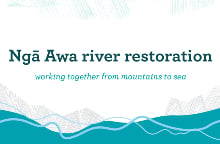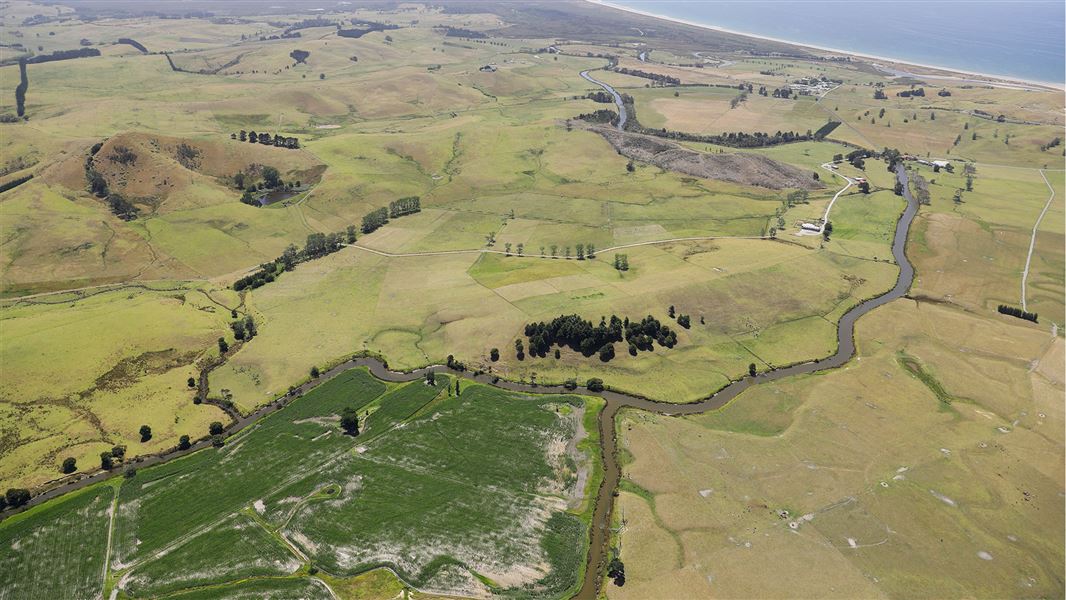About the catchment
The Doubtless Bay catchment covers an area of 55,605 ha on Northland’s east coast, about 30 km east of Kaitaia.
It contains dune lakes, gumlands, bogs and fens, which provide habitat for a range of plants and animals. People value its environment and history and the opportunities for recreation.
In the catchment there is intensive beef and dairy farming, and forestry, with pasture and grassland making up 42%, native forest 24%, mānuka and kānuka 20%, forestry 11% and gorse 1.5% of the total area.
View a map of the Doubtless Bay catchment (PDF, 3,165K)
Subcatchments
Three main rivers end in Doubtless Bay. From west to east they are:
- Aurere and Parapara streams, which converge at Aurere to form the tidal Awapoko River
- Waikainga and Te Awapuka streams, numerous smaller streams and the Peria River drain steep hill country around Maungataniwha and converge below Peria to become the Oruru River. The Oruru River flows north, joins the Paranui River and becomes the Taipa River.
- Oruaiti – the bay’s largest river. It begins in Otangaroa and ends in Mangōnui Harbour.
Treaty partners
This project brings together many hapū from marae in Doubtless Bay including Kenana Marae, Te Paatu ki Kauhanga Trust, Waimahana Marae, Parapara Marae and Karipore Marae. Other hapū are very welcome to join the catchment group.
Current restoration work
Revegetation options to increase climate change resilience
This report sets out 12 revegetation and restoration options for the Awapoko, Oruru and Oruaiti subcatchments. The options take climate change into account and are intended to build resilience to its expected impacts, especially drought, sea-level rise, wildfires and flooding. Social and economic preferences are also considered.
The report includes maps of different types of ecosystems in the area and an assessment of how vulnerable they are to the various impacts of climate change.
Revegetation besides streams and on erosion-prone land is an important part of freshwater restoration.
Read the report: Doubtless Bay Nga Awa revegetation options (PDF, 6,438K)
Read a DOC Blog about this research
Īnanga spawning habitat – baseline review
Īnanga are the most common native fish caught as whitebait. Their populations are declining and threatened by habitat degradation, climate change and over-fishing.
We are surveying a number of īnanga spawning sites in the catchment each year from 2023 to 2025. This work is carried out with The Whitebait Connection and local kaitiaki. The surveys are helpful for understanding more about īnanga spawning in our local rivers.
The habitat at each site is assessed, and then restored or enhanced to improve conditions for spawning. Restoration work can include planting native trees, fencing, pest and weed control and the use of straw bales for temporary habitat while the plants get established.
Wetland mapping
The wetlands in the catchment are being mapped using LiDAR satellite imagery. This will show where the wetlands currently are and where they used to be.
The information will guide and help prioritise our work with community groups to identify and restore wetlands. Restoring the wetlands is an important part of restoring the rivers.
Native plant nurseries
We are working with local nurseries and the community to make sure there is a supply of eco-sourced native plants for restoration work in the catchment.
Peria River geomorphology report
The Peria River is a subcatchment of the Oruru River in Doubtless Bay. A study of its geomorphology was commissioned because the riverbanks are eroding and there are concerns that if it is not addressed, erosion could harm restoration work in the area.
The study found that in this meandering river, erosion will continue to occur on the outside of bends, and the eroded material will continue to be deposited on the inside of bends. To reduce erosion, fencing to keep stock out and planting up to 10m beside the river was recommended.
The report noted that erosion would continue after riverside plants were established, but at a slower rate. Planting beside rivers also provides shade, filters out sediment and nutrients, and enhancesing the habitat and biodiversity of the river.
Peria River, Doubtless Bay restoration: Geomorphic assessment (PDF, 5,480K)
Local school programmes
Ongoing work with schools in the Doubtless Bay area is giving students opportunities to learn about restoring ecosystems, including the rivers, sea and land in the local area. The work includes monitoring, trapping, weed management, riverside planting and ensuring fish can move easily up and downstream. Northland Regional Council supports this project. Secondary school students can credit the time they spend towards their Duke of Edinburgh’s International Awards.
Training and workshops
A stream health monitoring assessment kit (SHMAK) workshop was organised and supported by Ngā Awa in 2002. It was hosted by Kauhanga Marae and run by The Whitebait Connection. The marae welcomed kaitiaki, farmers, students and members of restoration groups. This event created enthusiasm and provided resources for restoration work in the catchment.
Ngā Awa also ran a riparian management classification training workshop with NIWA in 2022.
Catchment surveys for taonga species
In 2022, several streams in the catchment were surveyed to identify the taonga species living there. Local kaitiaki were involved in the work that used environmental DNA, electric fishing and traditional methods.
Whakaweku (bracken leaves) were used to survey kēwai (freshwater crayfish) and other species. Whakawheku are placed in a stream and left for about 6 weeks before being removed and examined for insects, snails, fish and other species that may have settled on them.
We found kēwai, kakahi (freshwater mussels), tuna (short and longfin eels), lamprey and īnanga.
Hapū and local communities are interested in restoring habit for taonga species to increase their numbers in the catchment. More survey work is being carried out to find the best sites for this restoration work.
Project partners
Our project partners are Northland Regional Council, Far North District Council, Fulton Hogan, Summit Forests and Waka Kotahi NZ Transport Agency.
We also support groups that are already working in the catchment:
- Honeymoon Valley Landcare Trust
- Clean Waters to the Sea
Upcoming events
Community wānanga and training events are advertised on DOC’s Northland Facebook page. We welcome you and your whānau to register and come along.
Contact
If you have any questions or want to get involved, email us.
Email: info@doc.govt.nz

About Ngā Awa river restoration
Ngā Awa is a programme working collaboratively in priority catchments to restore freshwater biodiversity.
